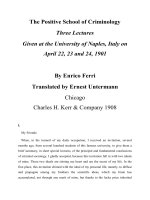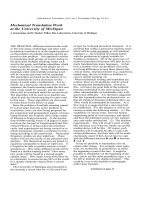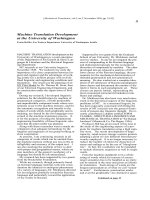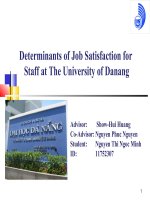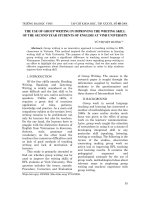Applying case method in teaching ESP at the university of security
Bạn đang xem bản rút gọn của tài liệu. Xem và tải ngay bản đầy đủ của tài liệu tại đây (6.6 MB, 167 trang )
VIETNAMESE NATIONAL UNIVERSITY- HO CHI MINH CITY
University of Social Sciences and Humanities
LE THI NGUYET
APPLYING THE CASE METHOD IN TEACHING ESP AT THE
UNIVERSITY OF SECURITY, HO CHI MINH CITY
A THESIS SUBMITTED IN PARTIAL FULFILLMENT
OF THE REQUIREMENTS FOR DEGREE OF
MASTER OF ARTS (TESOL)
Supervisor: NGUYEN THI KIEU THU, Ph.D.
Ho Chi Minh City- 2010
CERTIFICATE OF ORIGINALITY
I certify my authorship of the thesis submitted today entitled:
APPLYING THE CASE METHOD IN TEACHING ESP AT THE
UNIVERSITY OF SECURITY, HO CHI MINH CITY
in terms of the statement of Requirements of the theses
in Master’s Programs
issued by the Higher Degree Committee.
Ho Chi Minh City June, 2010
LE THI NGUYET
RETENTION AND USE OF THE THESIS
I hereby state that I, LE THI NGUYET, being the candidate for the degree of
Master of TESOL, accept the requirements of the University relating to the
retention and use of Master’s Theses deposited in the Library.
In terms of these conditions, I agree that the original of my thesis deposited in the
Library should be accessible for purposes of study and research, in accordance with
the normal conditions established by the Library for the care, loan and reproduction
of the theses.
Ho Chi Minh City, June 2010
LE THI NGUYET
ACKNOWLEDGEMENTS
I would like to express my sincere gratitude to the following people who have made
writing this thesis possible for me:
First of all, I would like to express my wholehearted thanks to my thesis supervisor,
Nguyen Thi Kieu Thu, Ph.D, at the University of Social Sciences and Humanities,
HCMC for her enthusiastic, constant guidance and valuable advice. Without her
assistance, patience, encouragement and advice, this thesis could not have been
completed. She has not only shown me the limitations of my own knowledge, but
also always guided me towards overcoming these problems.
Gratitude is also offered to the Board of Directors at the University of Security, who
gave me facilities and conditions to take part in this Master’s program.
I would also like to give many thanks to Mr. Pham Trac Kham, the Dean of the
Department of Foreign Languages at the University of Security, who always gave
me lots of support and encouragement to successfully implement this thesis.
I owe many thanks to my colleagues and friends not only for their endless
encouragement and support but also for their assistance in data collection. I simply
cannot find enough words to express my thankfulness to them.
Last but not least, I would also like to thank my husband, my parents and my
younger sisters for their loving support and encouragement that help me so much in
finishing this thesis.
ABSTRACT
The case method has been one of the most widely-used method in the area of ESP.
In fact, it is rather difficult to apply in teaching languages but many researchers
have realized its benefits. This thesis, therefore, attempted to find out whether the
case method was effective in enhancing students’ interest and communication skills
as well as their ability to deal with actual situations in professional contexts through
students’ attitude towards learning ESP with cases, and finally to discover how to
apply the case method effectively in teaching ESP at the University of Security.
The data were collected through surveys to students’ attitude with an experimental
teaching, classroom observations, questionnaires and pocket interviews to teachers.
It was found that most students felt interested and motivated when learning ESP
with the case method. They were more responsible for their own learning, thus
working harder. In addition, they actively participated in case activities such as
group discussions, role-playing or decisison-making. More importantly, students
could improve their communication skills as well as the skills of solving
professional situations and making decisions. However, despite the benefits of the
case method, many ESP teachers at the University of Security did not apply the case
method in their ESP classes.
Based on the findings, some suggestions for ESP teachers, ESP students, and
administrators were made to enhance the quality of teaching ESP at the University
of Security.
TABLES OF CONTENTS
Pages
Certificate of originality
i
Retention and use of the thesis
ii
Acknowledgements
iii
Abstract
iv
Table of contents
v
List of tables and abbreviations
xii
List of figures
xiii
Chapter 1: INTRODUCTION
1
1.1. Background
1
1.2. Statement of the purpose
3
1.3. Research questions
4
1.4. Significance of the Study
4
1.5. Terminology
5
1.6. Assumptions
7
1.7. Limitations
8
1.8. Organization of the Study
8
Chapter 2: LITERATURE REVIEW
2.1. An overview of English for Specific Purposes (ESP)
10
10
2.1.1. What is ESP?
10
2.1.2. General characteristics of ESP
11
2.1.3. Types of ESP
13
2.1.4. How is ESP different from GE?
15
2.1.5. Methodological approaches used in teaching ESP
17
2.2. The Case Method
19
2.2.1. A case
19
2.2.1.1. What is a case?
19
2.2.1.2. Important Features of a Case
20
2.2.1.3. Types of cases
21
2.2.1.4. Nature of a Teaching Case
23
2.2.2. Case method
24
2.2.2.1. Definitions
25
2.2.2.2. Types of Case method
27
2.2.3.The teacher and student roles
28
2.2.3.1. The teacher and student roles in a regular class
28
2.2.3.2. The teacher roles in an ESP case class
29
2.2.3.3. The student roles in an ESP case class
33
2.2.4. Advantages in the use of case method in teaching language
34
2.2.5. Drawbacks in the use of case method in teaching language
39
2.2.6. Effective case teaching strategies
41
2.3. Summary
42
Chapter 3: RESEARCH METHODODLOGY
43
3.1. Research questions
43
3.2. Research design
44
3.2.1. Research instruments
3.2.1.1. Experimental teaching
3.2.1.1.a. Purposes
44
44
44
3.2.1.1.b. Subjects
44
3.2.1.1.c. Teaching procedures
45
3.2.1.2. Class observations
51
3.2.1.2.a. Purposes
51
3.2.1.2.b. Subjects
51
3.2.1.2.c. Procedures
51
3.2.1.3. Questionnaire for ESP students
52
3.2.1.3.a. Subjects
52
3.2.1.3.b. Questionnaire design
53
3.2.1.3.c. Data Collection Procedure
53
3.2.1.4. Pocket interviews
53
3.3. Summary
55
Chapter 4: FINDINGS AND ANALYSIS
57
4.1. DATA ANALYSIS
57
4.1.1. Class observations
57
4.1.1.1. Teachers’ evaluation of ESP students’ attitude
57
towards their learning with the case method
4.1.1.2.
Teacher’s
evaluation
of
ESP
students’
58
improvements in English communication skills
4.1.1.3. Teacher’s evaluation of ESP students’ ability of
59
dealing with real
4.1.2. Students’ responses to the questionnaires
60
4.1.2.1. Students’ English background
60
4.1.2.2. The effectiveness of the case method in improving
61
students’
interest
and
their
communication
competence as well as their ability to deal with real
situations in professional contexts
4.1.2.3. Students’ attitude towards their ESP learning with
66
the case method
4.1.2.4. Students’ comments case activities, disadvantages
69
of the case method and necessary factors of ESP
teachers, which resulted in how to apply the case
method effectively in ESP classes.
4.1.3. Teacher interviews
4.2. FINDINGS
76
77
4.2.1. The ESP coursebook did not give advantages to ESP teachers in
78
teaching with the case method
4.2.1.1. The coursebook designers did not recognize the
78
importance of the case method and its benefits in
improving the quality of teaching ESP students,
therefore they neglected this method in the process of
designing the coursebook’ content.
4.2.1.2. The professional cases presented in the coursebook were
78
not satisfactorily and systematically arranged.
4.2.2. From ESP students
4.2.2.1. Students had positive attitude towards their learning and
79
79
the case method.
4.2.2.2. Students showed active performance in the experimental
79
classes
4.2.2.3. Students realized the importance and effectiveness of
79
the case method.
4.2.2.4. Some difficulties of learning with the case method were
acknowledged
80
4.2.3. From ESP teachers
80
4.2.3.1. The importance and benefits of the case method was
80
widely acknowledged among ESP teachers
4.2.3.2. ESP teachers admitted that the case method was
81
difficult for both teaching and learning though it was
very interesting and beneficial.
4.2.3.3. Many ESP teachers did not apply the case method in
81
their ESP classes
4.2.3.4. ESP teachers realized some difficulties of applying the
82
case method in teaching ESP at the University of
Security
4.3. SUMMARY
82
Chapter 5: CONCLUSION AND RECOMMENDATIONS
83
5.1. Conclusion
83
5.2. Recommendations
85
5.2.1. Recommendations for ESP teachers at the University of Security
5.2.1.1. ESP teachers ought to apply the case method in their
85
85
ESP classes to improve students’ communication skills.
5.2.1.2. ESP teachers ought to help students prepare for good
85
discussions.
5.2.1.3. ESP teachers should use many kinds of case activities to
90
arouse students’ interest in learning ESP.
5.2.1.4. ESP teachers ought to spend a lot of time preparing
lesson
plans
carefully
professional cases.
and
selecting
effective
94
5.2.1.5. ESP teachers should use current professional cases that
94
are updated and familiar with students
5.2.1.6. ESP teachers ought to use technological equipments
95
such as screens, projectors, laptops, etc. to enhance the
effectiveness of the case method in teaching ESP.
5.2.1.7. ESP teachers must create a collaborative and learner-
95
centered learning environment.
5.2.1.8. ESP teachers ought to identify the difficulties and
97
drawbacks of the case method in teaching ESP, admit
them and find out ways to overcome them.
5.2.1.9. ESP teachers ought to improve both ESP knowledge and
97
understanding of Vietnamese law and national security.
5.2.2. Recommendations for ESP students
98
5.2.2.1. Students ought to improve both GE and ESP vocabulary
98
5.2.2.2. Students ought to improve an understanding of
98
Vietnamese law and national security.
5.2.2.3. Students must take responsibility for their own learning
98
and find out their active strategies in learning ESP with
cases to exploit the effectiveness of the case method.
5.2.3. Recommendations for the Department of Foreign Languages at
99
the University of Security
5.2.3.1. Increasing the time for case activities in the course
99
syllabus
5.2.3.2. Writing more different kinds of case activities in the
100
coursebook so that ESP teachers find it easy to apply the
case method in teaching ESP. Moreover, professional
cases
should
be
presented
in
the
coursebook
satisfactorily and systematically.
5.2.3.3. Including case questions on mid-term and final exams
100
5.2.3.4. Holding some seminars about how to apply the case
101
method in teaching ESP.
5.2.4. Recommendations for the Board of Directors at the University of
101
Security
5.2.4.1. Equipping ESP classrooms with projectors and screens
101
that are needed to exploit the effectiveness of the case
method in teaching ESP.
5.2.4.2. Creating a motivating and convenient setting for students
102
to carry out case activities after class
REFERENCES
103
APPENDICES
110
Appendix A
……………………………………………………..
112
Appendix B
……………………………………………………..
115
Appendix C
……………………………………………………..
122
Appendix D
……………………………………………………..
128
Appendix E
……………………………………………………..
137
Appendix F
……………………………………………………..
145
Appendix G
……………………………………………………...
148
Appendix H
………………………………………………………
150
Appendix I
………………………………………………………
152
Appendix J
……………………………………………………….
153
Appendix K
……………………………………………………….
LIST OF TABLES AND ABBREVIATIONS
TABLES
Table 4.1: Students’ communication skills
Table 4.2: Effects of the case method on students’ future jobs
Table 4.3: The benefits of the case method
Table 4.4: Students’ attitude towards their ESP learning
Table 4.5: Comparison of the case method with the grammar-translation method
Table 4.6: Students’ evaluation towards interesting case activities in class
Table 4.7: Students’ evaluation towards class cases
Table 4.8: The disadvantages of the case method
Table 4.9: Necessary factors of teachers who teach ESP with cases
ABBREVIATIONS
ESP: English for Specific Purposes
GE: General English
ELT: English Language Teaching
ESP-B: Business English
IT: Information Technology
HCMC: Ho Chi Minh City
TESOL: Teaching English to Speakers of Other Languages
LIST OF FIGURES
Figure 4.1: Students’ years of learning English at school
Figure 4.2: Students’ results of General English in the previous semester
Figure 4.3: Students’ attitude towards their ESP learning with the case method
1
Chapter 1
INTRODUCTION
1.1. Background to the study
1.1.1. Rationale
To meet the requirements of the global integrated world, Vietnamese nonmajored students now need to gain both General English (GE) and English for
Specific Purposes (ESP). In the field of GE, many teachers have spent a lot of time
searching for effective teaching methods and techniques to help their students gain
both linguistic and communicative competence. Likewise, ESP teachers have aimed
to help students to be competent second language users in specific professional
fields, and helping them to deal with real professional situations is one of the key
learning objectives that ESP teachers pursue. In the area of ESP, one of the most
widely-used techniques has been the case method. Among its more salient
characteristics, as far as ESP is concerned, the case method is fundamentally
communicative. Professional authentic material is used and the process is totally
learner-centered.
Like students at other universities in Vietnam, those at the University of
Security take both General English and ESP courses. However, there is not enough
attention paid to searching for effective ESP teaching methods, so the ESP learning
is not learner-centered and interesting. In addition, students cannot apply the
theories that they have learnt in dealing with real professional situations. To solve
those problems, the author of this thesis, an English teacher at the University of
Security, always looks for effective methods to arouse ESP students’ interest and
communication skills.
2
At the University of Security, ESP has been taught theoretically with only
vocabulary, grammar and reading comprehension, which causes the ineffectiveness
and limits for students in communication. As a result, a more effective method
needed applying to give students more opportunities to practice knowledge,
concepts, and skills relevant to their specific professional field. Therefore, the case
method - a form of discussion teaching - is chosen because it can make students
more interested and motivated in their learning, and helps them achieve their
learning goals in improving their English communication skills as well as skills of
analysis, problem-solving and decision-making.
To sum up, this study discusses the application of the case method to the
teaching of ESP at the University of Security. Students are given some professional
situations (or cases) in English to deal with while improving their English
comprehension and communication skills.
1.1.2. Current situation of ESP teaching at the University of Security
In fact, most students at the University of Security studied 3-7 years of
General English in secondary school and high school. Before enrolling in their
English courses, they have to take a placement test to classify their English levels.
Based on their grade results, they are divided into different classes suitable to their
actual English levels. They study English as an obligatory subject for 6 terms (360
periods). After studying 5 terms of General English (300 periods) with the textbook
“English KnowHow- Book 1” and “English KnowHow- Book 2” by Therese Naber Angela Blackwell 2004, the students continue their ESP course for 60 periods. The
ESP coursebook used for teaching ESP students is “Start with Vocational English”,
compiled by the teachers of the Department of Foreign Languages at the University
of Security.
The ESP students are third-year students. There are 15 teachers in the
Department of Foreign Languages, but only 10 teachers have taught ESP. ESP
classrooms at the University of Security are not very large. There are about 34-38
3
students in each class. Chairs in the classrooms are arranged in double straight U for
students to be able to communicate with each other or discuss in groups easily. In
addition, some classes are equipped with a projector and a screen so that teachers
can apply IT in teaching English to make their teaching more interesting and
effective.
Moreover, the students here are boarders, that is, they all live in the
university dormitory during the terms except for the holidays. Thus, this learning
environment facilitates their teamwork, especially group discussions.
However, there are still a lot of disadvantages in teaching ESP students with
the case method at the University of Security. The first difficulty that ESP teachers
have faced is that the coursebook is not really case-based, so that they feel
discouraged to apply the case method in their teaching. The number of cases in the
coursebook is limited so teachers have to spend much time looking for professional
cases and preparing their lesson plans. As a result, not many teachers are willing to
spend time and energy looking for effective methods to improve the students’
communication skills. Second, the teaching time limit is also a difficulty for using
the case method in ESP classes. Teaching with cases requires a lot of time for
students to discuss problems with their friends and give their own decisions.
Consequently, the amount of current teaching time for each unit is not enough for
group discussions. Moreover, not all classrooms are equipped with projectors and
screens, whereas ESP teachers really need this supporting technology equipment
when they apply the case method in their classes so that they can make their
teaching more lively, exciting and effective.
1.2. Statement of the purpose
The purposes of this study, therefore, are (1) to discover whether the case
method is effective in arousing students’ interest in learning ESP, in enhancing their
English communication skills and ability to deal with real situations in professional
4
contexts; (2) to find out efficient ways to apply the case method in teaching ESP at
the University of Security.
1.3. Research question
For its purposes, the study aimed to answer one main question as follows
Is the case method effective in enhancing students’ interest, their
communication skills and their ability to deal with real situations in
professional contexts?
1.4. Significance of the Study
This study is significant in both theory and practice for several reasons as
follows.
Firstly, there have not been any researches on teaching ESP with real
professional cases at the University of Security. Therefore, this study will be the
first to investigate the issue above.
Secondly, the quality of teaching and learning ESP at the University of
Security is not as good as expected, that is, students’ interest and their English
communication skills are not enhanced after the ESP course finishes. Moreover,
they do not know how to apply ESP knowledge in dealing with real professional
cases. Thus, it is necessary to do one or more researches in this domain to improve
the situation.
Finally, this study focuses on teaching ESP with real professional cases at the
University of Security. Therefore, it helps provide a deeper understanding of the
advantages and practical effectiveness of this method. Then it also provides useful
and deliberate recommendations about effective strategies to apply the case method
5
in teaching ESP. In addition, the study will also serve as a meaningful reference for
teachers of ESP at the University of Security as well as at other universities.
1.5. Terminology
1.5.1. The University of Security is the one in which learners are trained
with the knowledge of national security, criminal affairs and law as well as skills of
investigation in order to be security officers.
1.5.2. ESP
ESP stands for English for Specific Purposes. Hutchinson and Waters
(1987:99) stated that, “ESP is an approach to language teaching in which all
decisions as to content and method are based on the learner’s reason for learning.” It
fulfils the needs of adult learners who need to learn a foreign or second language for
use in their specific fields such as science, technology, medicine, leisure, academic
learning, etc.
1.5.3. Case/ Situation/ Problem
Case is “a description of an actual situation, commonly involving a decision,
a challenge, an opportunity, a problem or an issue faced by a person (or persons) in
an organization” (J.A. Erskine, M.R. Leenders, L.A.M. Mauffette-Leenders, 1999:
2).
From the definition above, the writer of this study uses the term case and
situation interchangeably. The term problem is sometimes used in this research;
however, it only presents an aspect of a case. It cannot replace the term case
because a case involves many aspects such as a decision, a challenge, an
opportunity, a problem or an issue.
6
1.5.4. Case method/ problem-based learning/ case-based teaching/ case
study/ problem-solving teaching/ case study method/ case-based approach
“Case method is seen as a technique based on analysis, discussion, and
decision-making” (A. Almagro Esteban and M.L. Pérez Canãdo, 2003: 138). That
is, case method teaching is a form of discussion teaching in which students prepare
a case, either individually or in groups, and then seek collectively through in class
discussion to discover a solution to the problem presented by the case. In fact, there
is a confusion in the way many researchers use different terms to refer to this
teaching method. First, the terms case method, problem-based learning, and casebased teaching are often used interchangeably with an occasional interspersing of
the term case study. The term commonly used across all disciplines to define
teaching with cases or problems is case method. What are the similarities and
differences among each of these terms as used in discussions of teaching from cases
or problems?
First, the term case study refers to the final product of qualitative data
collection and analysis; the case study is a written account of both the case and its
analysis. Conversely, a case as used in teaching typically includes only the “story”
without the accompanying analysis; that analysis is left to students. Therefore, the
term case study is often used inaccurately to describe a case for teaching. The term
case study, because it most correctly describes the product of qualitative inquiry and
not an instructional method, is excluded from further discussion.
Second, the terms problem-based learning and case-based learning are
frameworks for an instructional process and a curriculum structure respectively.
Third, the term case method is a general descriptor for teaching with cases or
situations. Most often, this term refers to traditional methods of teaching in law or
business. It is a generic term that can include teaching from cases or situations with
either contained or open-ended analysis. Besides, some researchers such as Peter
Daly (2003) and Jenny Miller (1996) used the term case method interchangeably
with the term case study method or case-based approach to refer to a teaching
method with cases. And another one contributing to the confusion is the term
7
problem-solving teaching. However, problem-solving is just a specific aspect of
teaching with the case method like decision-making or role-playing.
To sum up, with the preference for the definitions of some researchers such
as A. Almagro Esteban and M.L. Pérez Canãdo (2003), J.A. Erskine, M.R.
Leenders, and L.A.M. Mauffette-Leenders (2003), the writer of this study decided
to use the term case method to refer to teaching with actual cases or professional
situations in ESP classes.
1.5.5. Collaborative learning
Collaborative learning is working together and supporting each other to
maximize learning and task outcomes. It is the opposite of competitive learning
where each learner is trying to be better than his companions.
1.5.6. Learner–centered
An approach to classroom methodology that puts learners’ needs and
interests at the centre of the learning program.
1.5.7. Language facilitator
The person who has a native speaker competence in the language being
learnt and can provide all the necessary linguistic input to facilitate the activities
and task achievement.
1.6. Assumptions
The study was based on the following assumptions:
1. The sample population of students was representative of the majority of
students at the University of Security.
2. The methods and procedures of data collection and analysis were reliable
and appropriate to obtain the information to answer the research questions.
8
3. The respondents and informants were honest in their responses, and had
no difficulty understanding the items of the research questions.
4. All sample students who take part in the survey have been chosen
randomly.
1.7. Limitations
The investigation for experimental teaching and questionnaires of this study
mainly covered a period of the year 2008 for four classes of non-majored students at
the University of Security. This study confines itself to experimental teaching, class
observation, questionnaires and interviews. Additionally, the study has been done
on a small scale because of work constraints, time constraints and the requirements
of the thesis itself. Therefore, further researches are needed in order to make the
matter clearer and more persuasive.
In addition, althought ESP is required in many universities in Vietnam, each
major in the universities has its own textbook, thus textbooks for Security are not
widespread on the market. Therefore this study is restricted to the scope of the
University of Security, and its recommendations will be applied the most effectively
in this university. Additionally, the purposive sampling procedure decreases the
generalizability of findings. Thus, this study will not be generalizable to all
universities. However, recommendations from this study may also be beneficial to
ESP teachers at other universities.
1.8. Organization of the Study
In order to answer the two research questions, the thesis is organized into
five chapters as follows.
9
Chapter 1 provides the background of the thesis. It figures the rationale of
the study and current situation of ESP teaching at the University of Security. It also
emphasizes the importance of the case method on students’ communicative
competence and ability to deal with professional cases. Besides, chapter 1 also
introduces the purpose, research questions, significance, terminology, assumptions
and limitations of the study.
Chapter 2 presents a review of the literature of the study. It consists of
discussions on various viewpoints on ESP, the case method with its definition,
types, history and application, advantages, drawbacks, case teaching strategies as
well as the roles of the teacher and student in ESP case class.
Chapter 3 describes the research methodology. It shows the ways in which
necessary information to write the thesis has been obtained. Each instrument
contributes a certain type of information and all of them together provide the sound
knowledge on the matter to help the writer of the study finish her work.
Chapter 4 presents the data analysis. The source of data comes from the
experimental teaching, class observation, questionnaires and interviews. In this
chapter, the writer of the study tries to discover whether the case method is effective
in enhancing students’ interest in learning ESP, their English communication skills
and their ability to deal with real situations in professional contexts, the result of
which will eventually yield efficient ways to apply the case method in teaching ESP
at the University of Security.
Chapter 5 offers a number of recommendations on how the case method can
be effectively applied in teaching ESP and suggests some changes for current ESP
teaching at the University of Security. Moreover, this chapter also provides a
conclusion to sum up the main points of the study.
10
Chapter 2
LITERATURE REVIEW
In this chapter, the literature review of the study is presented with the
purpose of providing the theoretical framework for the research about ESP and case
method in ESP teaching. This chapter consists of two main parts:
(1) an overview of ESP including its definition, characteristics, types and
methodological approaches in teaching ESP
(2)
the case method including
(a) an overview of teaching cases
(b) the case method with its definition, types, history and
application, advantages, drawbacks, case teaching strategies as
well as the roles of the teacher and student in ESP case class.
2.1. An overview of English for Specific Purposes (ESP)
2.1.1. What is ESP?
Up to now, ESP has been defined differently by various authors. Some
people described ESP as simply being the teaching of English for any purpose that
could be specified. However, others were more precise describing it as the teaching
of English used in academic studies or the teaching of English for vocational or
professional purposes.
Strevens (1988: 12) suggests a definition which covers more detailed
characteristics of an ESP course. He states “English for specific purposes is a
particular case of the general category of special-purpose language teaching. The
same principles apply no matter which language is being learnt and taught”.
11
A broader definition of ESP is the one provided by Hutchinson and Waters
(1987) who theorize ESP as an approach to language teaching which takes into
account the learners’ reasons for learning in making decisions related to content and
method. They stated, “ESP is an approach to language teaching in which all
decisions as to content and method are based on the learner’s reason for learning”
(Hutchinson and Waters, 1987: 98).
In fact, there is no specific definition of ESP, that is, no distinction has been
made between ESP (English for specific purposes), EOP (English for occupational
purposes) and EAP (English for academic purposes). Yet, there is a tendency for
foreign language teachers and applied linguists to consider EOP and EAP as the two
broad categories of ESP. For this reason, authors such as Sinha and Sadorra (1991:
10) referred to ESP as “a generic term used to indicate an approach practiced in
teaching and learning of content-oriented English for any very specific purpose”.
2.1.2. General characteristics of ESP
Streven (1980), Robinson (1980) and Widdowson (1983) have agreed that an
ESP course would have the following features:
•
It is purposeful and aimed at the successful performance of occupational
or educational roles by an individual or a group.
•
It is based on an analysis of the students’ needs and is tailor-made to meet
these needs.
•
It may differ from another general language course in its selection of
skills, themes, topics, situations, functions, language and methodology.
Additionally, from his own definition, Strevens goes on to maintain that a
definition of ESP needs to distinguish between absolute characteristics and variable
characteristics as follows.
*Absolute characteristics:
ESP consists of English language teaching which is:




